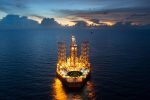Namibia’s burgeoning oil sector, hailed as one of the world’s most exciting new frontiers following major discoveries by Shell, TotalEnergies, and Galp, is facing a significant bottleneck. The global shortage of Floating Production, Storage, and Offloading (FPSO) vessels and soaring day rates for high-specification drilling rigs are emerging as critical constraints, potentially delaying first oil and inflating project budgets. Compounding these logistical and financial hurdles, oil majors are increasingly vocal about the complex geological challenges and are calling for greater policy clarity from the Namibian government to secure final investment decisions.
The industry’s sequencing is now a high-stakes puzzle. TotalEnergies is eager to appraise its giant Venus discovery, while Galp has recently announced a significant find at its Mopane well. However, industry sources indicate that Galp has expressed significant concerns regarding the technical complexity of the Mopane find. The reservoir characteristics, while highly prolific, present substantial engineering challenges that will require an advanced and costly development solution, further intensifying the need for a clear and stable fiscal environment to make the project economically viable.
This sentiment echoes across the industry. Executives from all major operators have emphasized that final investment decisions hinge not just on securing hardware but also on policy clarity from the Namibian government. Key areas of focus include finalizing fiscal terms, establishing defined and achievable local content regulations, and ensuring efficient and predictable timelines for environmental and regulatory approvals. The lack of a finalized legal framework creates uncertainty for the massive capital expenditures required.
The FPSO crunch: A seller’s market
An FPSO is a capital-intensive, custom-built vessel that serves as a mobile offshore factory, processing hydrocarbons, storing oil, and offloading it to shuttle tankers. The lead time for a new FPSO can exceed three to four years from order to first oil. Currently, global shipyard capacity is stretched thin, with a queue of projects from Guyana and Brazil to the North Sea all vying for the same specialized manufacturers.
This scarcity has created a fiercely competitive “seller’s market.” Securing an FPSO has become a prerequisite for FID, and operators are now engaging in early and complex negotiations to lock in units. For Namibia, this means the development timeline for its first project is less about the subsurface potential—which is proven to be excellent but complex—and more about securing this critical surface infrastructure. The cost implication is severe. Day rates for chartering an FPSO have skyrocketed, and the cost of building a new one has increased by 20-30% due to inflation in the steel and energy markets, directly impacting the break-even price for Namibian barrels.
Drilling rig costs soar amid active and planned campaigns
Parallel to the FPSO challenge is the soaring cost of deepwater drilling rigs. The ultra-deepwater drillships capable of operating in Namibia’s waters are in high demand globally. Day rates for these top-tier units have climbed from lows of around $150,000-$200,000 per day several years ago to well over $400,000-$500,000 per day today.
This is acutely felt in Namibia, where multiple active and planned campaigns are underway. Shell is currently in the midst of a multi-well campaign and has officially announced its intention to drill again next year, underscoring its long-term commitment to the basin. Alongside the majors, smaller players are also advancing their programs. Rhino Resources, for instance, is preparing for its own drilling campaign on Block 2914A, further adding to the competition for the limited number of available high-specification rigs. For any campaign that can last 100 days or more per well, the soaring rig rates translate to tens of millions of dollars in additional costs, forcing operators to be extremely selective with their drilling targets.
Strategic implications for Namibia
These combined industrial and policy constraints are dictating the pace of Namibia’s oil agenda. Analysts suggest that the first project to secure both an FPSO and clear regulatory footing will likely be the first to achieve first oil, granting a significant strategic and economic advantage.
TotalEnergies, with its vast project management experience and leverage in the market, is often cited as being in a strong position to navigate these supply chain challenges for its Venus find. However, Shell and Galp are formidable competitors for these scarce resources. The Namibian government, while eager to see rapid development and revenue generation, is also aware that these external constraints and internal policy decisions could impact its ambitious timeline. The situation underscores the importance of strategic project planning and may incentivize collaboration between operators and government to optimize infrastructure sharing, regulatory alignment, and sequencing to benefit the entire country’s development agenda.
In conclusion, while the geology of the Orange Basin has provided the opportunity, the mechanics of global industrial supply and the finalization of a clear, competitive policy framework will play an outsized role in determining how and when Namibia transforms its oil discoveries into tangible economic wealth.










